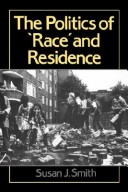Human geography
1 total work
Moving beyond geographers' traditional concern with pattern and process, this text explores the political and legislative history of racial segregation in Britain. It provides a critical commentary on the development of national and local housing policy, on the operation of the major markets and institutions, and on the organization of urban management. Collating a variety of research, Smith argues that residential segregation in Britain is an expression of racial inequality. This book rejects the reality of race as an explanatory construct, focusing instead on how and why races are constituted through economic, political and social activity. It is a contribution to the growing literature in search of an anti-racist social science. The book explores the interface of social geography, social administration and political science. It collates a body of data to provide a reinterpretation of racial segregation.
